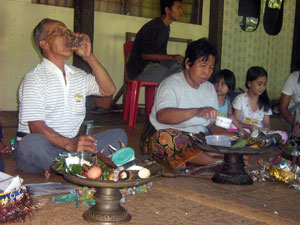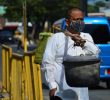The indigenous peoples of the Malaysian state of Sarawak have to contend with forces of tradition and development that often clash. The resultant cultural, economic and political stirrings are not unlike what the Lumads in Mindanao go through. Davao Today associate editor Germelina A. Lacorte, who spent weeks in Sarawak earlier this year as part of her journalism fellowship with the Southeast Asia Press Alliance, chronicles the struggles of our neighboring tribes.

House of Generations. A longhouse, as its name implies, is a very long house made of individual houses (more like rooms) built next to each other. It is headed by the kampung (village) headman, a counterpart of the Filipino barangay captain; one longhouse is about the size of one barangay. Historians traced seven generations of Ibans who have lived in three longhouses, such as this one with 67 rooms, along kampung Ensika in a span of a hundred years. (davaotoday.com photo by Germelina A. Lacorte)
SADONGJAYA, Sarawak, Malaysisa — The roar of engine drowns all sounds inside the small motorboat packed with passengers anxious to get to the other side of Sadong river from the small Sarawak town of Sadong Jaya.
It�s high tide, the fastest way for Nicholas Mujah Ason, a 45-year-old Iban, to get to his longhouse in a remote upriver kampung (village) on the eve of the state-declared gawai, a festival rooted in the ancient rituals of Ibans and other Sarawak tribes.
No road has linked his riverside kampung to the city, yet. But when seawater from the South China Sea swells the mouth of the Sadong river, it is easier for people to travel to their longhouses by boat.
For centuries, Mujah�s ancestors had traveled like this. Seven generations of Ibans had lived in three longhouses in this riverside kampung of Ensika in a span of a hundred years, he says. To get there, he had to cross Sadong to the riverside town of Sibangan and take another boat upriver until he reaches the smaller tributary called Ensika that finally leads to his kampung.
A trip to town is hard but the isolation has not protected the tribe from the onslaught of change and development that have taken a toll on their culture and their lands.

Thanksgiving Ritual. Light banter, in between shots of tuak, as Ibans cut morsels of food to offer to the spirits during the miring (spirit offering).(davaotoday.com photo by Germelina A. Lacorte)
INSIDE Mujah�s kampung, at the height of the gawai, the onslaught of change is apparent.
Three divergent sets of religious beliefs simultaneously occur in the 67-door longhouse. In the morning of May 31, people in the longhouse visit the ancestral graves to fulfill the age-old tradition of making offerings to the spirits.
But toward midnight, upon Mujah�s arrival, an Anglican catechist, who is his brother, leads the Anglican service, attended by most of the people in the longhouse. The following day, upon the sound of the gong, everyone gathers again and prepares food at the ruai, the gallery outside each longhouse door, where one of the Ibans� remaining tribal priests dances and chants to offer food to the spirit world.
Somewhere within other doors of that longhouse, Mujah says, another ceremony is also taking place among those who profess the new faith of Bahai, which has won adherents among people in the longhouse.
Indigenous Peoples









